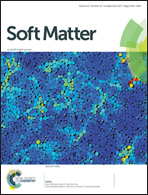Force percolation of contractile active gels
Abstract
Living systems provide a paradigmatic example of active soft matter. Cells and tissues comprise viscoelastic materials that exert forces and can actively change shape. This strikingly autonomous behavior is powered by the cytoskeleton, an active gel of semiflexible filaments, crosslinks, and molecular motors inside cells. Although individual motors are only a few nm in size and exert minute forces of a few pN, cells spatially integrate the activity of an ensemble of motors to produce larger contractile forces (∼nN and greater) on cellular, tissue, and organismal length scales. Here we review experimental and theoretical studies on contractile active gels composed of actin filaments and myosin motors. Unlike other active soft matter systems, which tend to form ordered patterns, actin–myosin systems exhibit a generic tendency to contract. Experimental studies of reconstituted actin–myosin model systems have long suggested that a mechanical interplay between motor activity and the network's connectivity governs this contractile behavior. Recent theoretical models indicate that this interplay can be understood in terms of percolation models, extended to include effects of motor activity on the network connectivity. Based on concepts from percolation theory, we propose a state diagram that unites a large body of experimental observations. This framework provides valuable insights into the mechanisms that drive cellular shape changes and also provides design principles for synthetic active materials.



 Please wait while we load your content...
Please wait while we load your content...